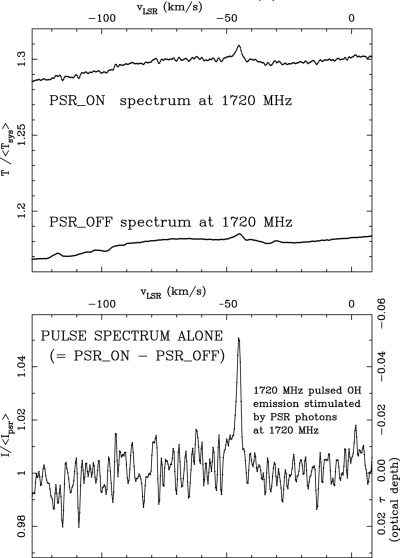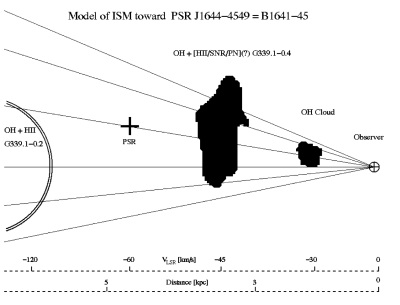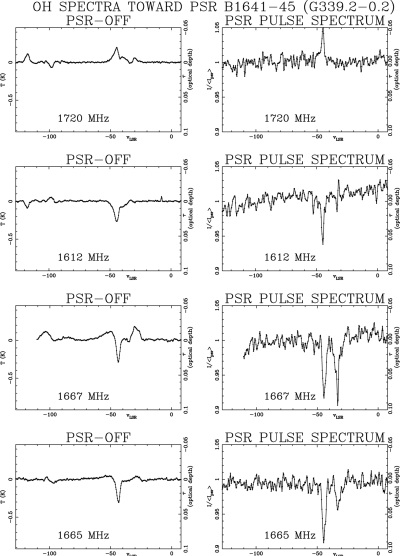Discovery of pulsed OH maser emission stimulated by a pulsar
|
J. Weisberg (ATNF / University of Sydney / Carleton College, USA); S. Johnston (ATNF), B. Koribalski (ATNF), & S. Stanimirovic (University of California, Berkeley, USA) Pulsars have proved to be outstanding probes of the interstellar medium. A team of astronomers led by Joel Weisberg has recently embarked on a new type of pulsar-ISM study that uses binned pulsar spectrometry of the OH line. In this approach, spectra are accumulated toward pulsars, with the spectra recorded separately during the pulsar pulse and in the interval between pulses. This makes it possible to isolate the effects of the ISM on the pulsar signal and to study the medium along the line of sight. This technique was used with the Parkes radio telescope to observe "on" and "off' spectra towards 18 pulsars in the inner Galaxy. For one source, PSR B1641-45 , interstellar OH lines were detected in the pulsar spectrum. This was only the second detection of interstellar OH towards a pulsar and the first time where the OH towards the pulsar is seen in emission as well as in absorption. The OH emission line seen towards PSR B1641-45 is caused by maser processes. Although there is extensive indirect evidence for maser activity in the ISM, stimulated emission of radiation has never been directly observed in astrophysical situations. For PSR 1641-45, the broadband pulsar spectrum exhibits excess line emission at 1720 MHz as the pulsar's photons stimulate the creation of additional photons in an intervening OH cloud. This excess emission switches on and off with the pulsar, clearly demonstrating its stimulated nature. Figure 1 displays the 1720-MHz spectra toward PSR B1641-45. The pulsar-off spectrum, acquired in the interval between pulses, shows both emission and absorption against other background sources lying within the Parkes beam. The pulsar-on spectrum appears at first glance to be similar. However, when these two spectra are differenced, it is clear that there is excess signal at the line frequency during the pulse - the broadband pulse signal has been amplified by stimulated emission at this frequency. Although maser emission from OH clouds in the ISM has long been studied, these are the first measurements that directly demonstrate the stimulated amplification of a signal propagating through the interstellar medium: the maser amplification is clearly modified as the pulsar cycles on and off. Since this stimulated emission is driven by the pulsar pulse, it varies on a timescale of a few milliseconds, orders of magnitude shorter than the quickest maser variations previously detected. From the strength of the maser line it can be calculated that approximately five excess line photons are stimulated in the cloud for every 100 passing through it. Pulsar B1641-45 lies in the inner Galaxy near the galactic plane, at (l,b) = (339.2, -0.2). Other available measurements of this region have been combined with the Parkes observations to create a schematic model of the ISM in the direction of the pulsar (see Figure 2). The model has been constructed using distances derived from kinematic analyses of radial velocity measurements. In this region of sky, the ionised hydrogen (HII) region G339.1-0.4 lies between the Earth and the pulsar, while the more distant HII region, G339.1-0.2, lies beyond the pulsar. Figure 3 displays spectra toward PSR B1641-45 at the four 18-cm OH lines. Pulsar-off spectra are shown in the left column while pulsar-on spectra are displayed in the right column. A strong OH line at a velocity of -45 km s-1 is evident in all eight spectra. The line is seen in absorption at 1612, 1667, and 1665 MHz and in emission at 1720 MHz. This line is likely to occur in OH gas associated with or near the HII region G339.1-0.4, since the velocity of the line is similar to the velocity of the HII region. Another OH line at a velocity of -30 km s-1 is also present in most of the spectra including the 1665 and 1667 pulsar spectra. This line may also be associated with G339.1-0.4, or a nearby region. Another interesting phenomenon can be seen in Figure 3. Each 1720-MHz spectrum (top row) is an inverted copy of the 1612-MHz spectrum (second row). This mirroring, known as "conjugate" line behaviour, results from the initial states of both transitions being overpopulated by an identical physical process, so that the degree of overpopulation is the same at both 1612 and 1720 MHz. Figure 3 also shows that the pulsar-on spectra (right column) exhibit much stronger absorption and stimulated emission than do the corresponding pulsar-off spectra (left column) at the same velocities. This can be explained as a solid-angle effect if the very narrow interstellar column sampled by the pulsar signal possesses significantly different properties from the much more extended medium sampled in the pulsar-off spectrum. The pulsar pulse may interact with a small, dense OH cloudlet whose properties are diluted in the beam-averaged pulsar-off spectrum. This behaviour differs markedly from HI, where absorbing columns of very different angular solid angles exhibit similar statistics. In retrospect, this result is not too surprising, as molecular gas is known to be more clumped than neutral gas. The Parkes search for OH absorption and stimulated emission in the spectrum of pulsars yielded many interesting results in the direction of the pulsar B1641-45. In future work, the authors plan also to study recombination lines toward this pulsar in an effort to further understand the interstellar medium in this direction. |
|



